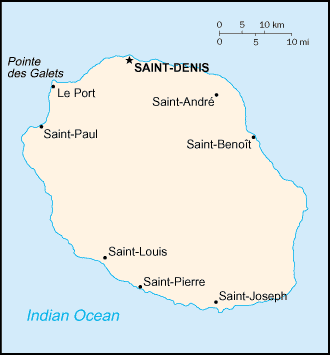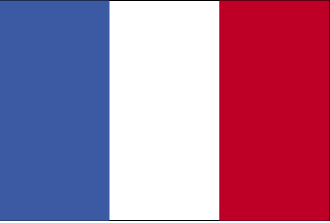
|
Reunion Island
Background:
The Portuguese discovered the uninhabited island in 1513. From the 17th to the
19th centuries, French immigration, supplemented by influxes of Africans,
Chinese, Malays, and Malabar Indians, gave the island its ethnic mix. The
opening of the Suez Canal in 1869 cost the island its importance as a stopover
on the East Indies trade route.
Location:
Location: Southern Africa, island in the Indian Ocean, east of Madagascar
Area: Total: 2,517 sq km, water: 10 sq km, land: 2,507 sq km.
Area - comparative: Slightly smaller than Rhode Island.
Coastline: 207 km.
Climate and Terrain:
Climate: Tropical, but temperature moderates with elevation; cool and dry from
May to November, hot and rainy from November to April.
Terrain: Mostly rugged and mountainous; fertile lowlands along coast.
Natural resources: Fish, arable land, hydropower.
Geography - note: This mountainous, volcanic island has an active volcano,
Piton de la Fournaise; there is a tropical cyclone center at Saint-Denis, which
is the monitoring station for the whole of the Indian Ocean.
People:
Population: 755,171.
Ethnic groups: French, African, Malagasy, Chinese, Pakistani, Indian.
Religions: Roman Catholic 86%, Hindu, Muslim, Buddhist.
Languages: French (official), Creole widely used.
Government:
Dependency status: Overseas department of France.
Capital: Saint-Denis.
Economy overview:
The economy has traditionally been based on agriculture, but services now
dominate. Sugarcane has been the primary crop for more than a century, and in
some years it accounts for 85% of exports. The government has been pushing the
development of a tourist industry to relieve high unemployment, which amounts
to one-third of the labor force. The gap in Reunion between the well-off and
the poor is extraordinary and accounts for the persistent social tensions. The
white and Indian communities are substantially better off than other segments
of the population, often approaching European standards, whereas minority
groups suffer the poverty and unemployment typical of the poorer nations of the
African continent. The outbreak of severe rioting in February 1991 illustrates
the seriousness of socioeconomic tensions. The economic well-being of Reunion
depends heavily on continued financial assistance from France.
Statistics:
Telephones - main lines in use: 268,500.
Telephones - mobile cellular: 197,000.
Radio broadcast stations: AM 2, FM 55.
Radios: 173,000.
Television broadcast stations: 35 (plus 18 low-power repeaters).
Televisions: 127,000.
Internet users: 10,000.
Railways: 0 km.
Highways: Total: 2,724 km, paved: 1,300 km (including 73 km of four-lane
road). unpaved: 1,424 km.
Airports: 2.
Return to Visiting Locations
|

